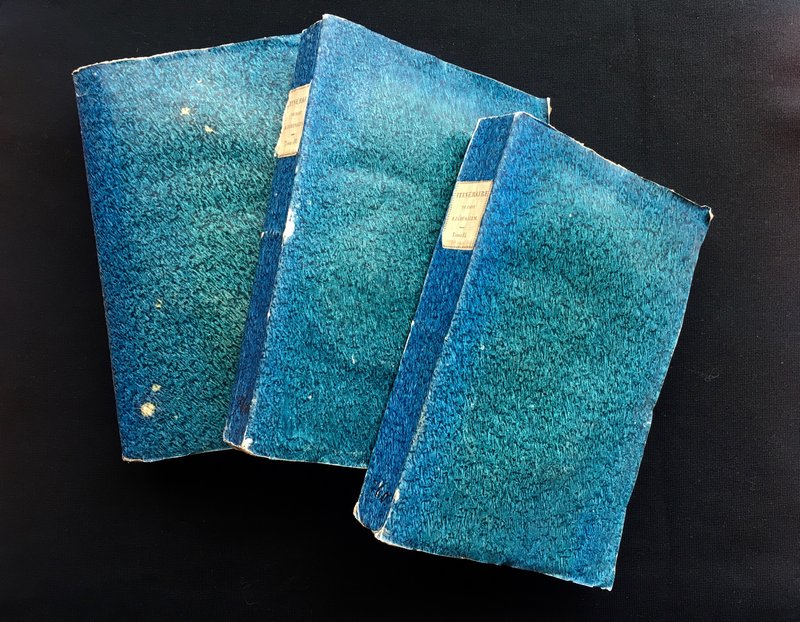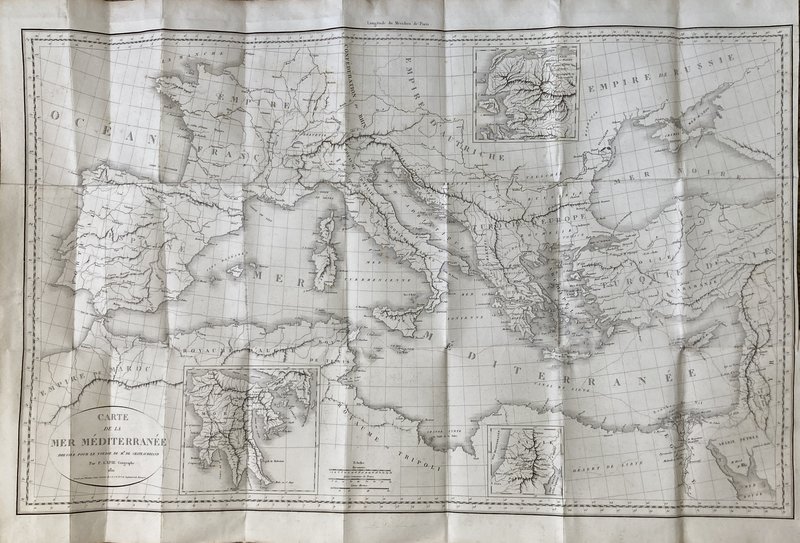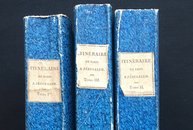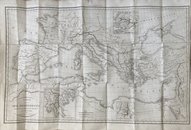Itinéraire de Paris a Jérusalem et de Jérusalem a Paris, en allant par la Grece, et revenant par l'Egypte, la Barbarie et l'Espagne
$750

Chateaubriand, F.A. de. Itinéraire de Paris a Jérusalem et de Jérusalem a Paris, en allant par la Grece, et revenant par l'Egypte, la Barbarie et l'Espagne.
Paris: Le Normant, 1812. Third Edition.
3 volumes. 8vo: cix, 276pp; [4], 408pp; [4], 375pp. With large (98 x 67.5 cm) folded engraved map, untrimmed in publisher's original azur paste paper wrappers with printed label to spines. The author of René, and Atala, and a major figure in the Romantic movement, François-Auguste-René de Chateaubriand (1768-1848) provides here a narrative that is both historiography and a Grand Tour guide through antiquity.
The author contextualizes the rich history of classical antiquity with the less than opulent contemporary state of Greece, Turkey, and the Holy Lands under the Ottoman Empire in the early 19th century. Replete with quotations and insightful references, the Itinéraire also reflects the intellectual profile of the contemporary, educated European traveler. The first edition was exhausted so quickly that a second edition was called for the same year. This 3rd edition includes the author’s corrections of dates, printed responses to various commentators on the earlier editions, and other refinements, such as moving citations to the end of the chapters. Chateaubriand’s journey lasted from July 1806 to June 1807.
His itinerary, which runs from Paris to Jerusalem and from Jerusalem back to Paris, passes through Greece, and returns through Egypt, North Africa and Spain, is presented seven parts: (I) Voyage de la Grèce; (II) Voyage de l'Archipel, de l'Anatolie et de Constantinople; (III) Voyage de Rhodes, de Jaffa, de Béethléem et de la Mer Morte; (IV & V) Voyage de Jérusalem; (VI) Voyage d'Egypte; (VII) Voyage de Tunis et retour en France.
Contemplating the past from the ruins of the present:
Chateaubriand’s observations are characterized by a poet’s thoughtful sensibility, but also with a historian’s scrutiny:
Je faisais ces réflexions à la vue des débris du temple de Sunium: ce temple était d'ordre dorique, et du bon temps de l'architecture. [...] Toutefois ce spectacle était triste, lorsque je venais à songer que je le contemplais du milieu des ruines. Autour de moi étaient des tombeaux, le silence, la destruction, la mort, ou quelques matelots grecs qui dormaient, sans soucis et sans songes, sur les débris de la Grèce. Vol. 1, pp. 253-55.
I made these reflections upon the sight of the remains of the Temple of Sunium: this temple was of the Doric order, and of the best period of architecture. [...] However, this spectacle was sad, when I came to think that I was contemplating it from the midst of the ruins. Around me were tombs, silence, destruction, death, or a few Greek sailors who slept, carefree and dreamless, on the debris of Greece.




